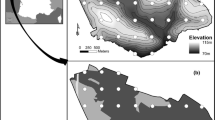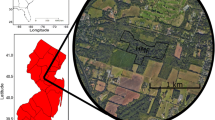Abstract
Despite concern expressed two decades ago, there has been little recent discussion about continuing declines of migrant bird populations. Monitoring efforts have been focused almost exclusively on the breeding grounds. We describe the long-term decline of a winter-resident bird population in Guánica Commonwealth Forest, Puerto Rico, one of the last remaining tracts of high-quality tropical dry forests in the Caribbean. The winter bird community has exhibited dramatic declines, with constant-effort mist netting now capturing about one-third as many birds as it did 20 years ago. Population estimates for the three most common species have declined dramatically, even though survival rates have remained constant, and other species are now virtually absent from a site where they once were fairly common. Although explanations for these declines are speculative, particularly because they involve multiple species, we argue that the strength and duration of these declines in well-preserved dry forest within a biosphere reserve should stimulate renewed discussion of migrant population trends and comparison with other recent monitoring activities.



Similar content being viewed by others
Abbreviations
- AICc :
-
Akaike’s information criteria, corrected for small sample size
- WNV:
-
West Nile Virus
References
Arendt WJ (1992) Status of North American migrant landbirds in the Caribbean region: a summary. In: Hagan JM III, Johnston DW (eds) Ecology and conservation of Neotropical migrant landbirds. Smithsonian Institution, Washington, pp 143–171
Burnham KP, Anderson DR (1998) Model selection and multi-model inference: a practical information theoretic approach. Springer, New York
Burnham KP, Anderson DR, White GC, Brownie C, Pollock KH (1987) Design and analysis methods for fish survival experiments based on release-recapture. Am Fisheries Soc Monogr 65(5):1364–1372
Chao A, Shen TJ (2010) Program SPADE (Species prediction and diversity estimation). http://chao.stat.nthu.edu.tw. Accessed 4 Feb 2012
Colwell RK, Coddington JA (1994) Estimating terrestrial biodiversity through extrapolation. Philos Trans R Soc Lond B 345:101–118
Danielsen F, Burgess ND, Balmford A (2005) Monitoring matters: examining the potential of locally-based approaches. Biodiv Conserv 14:2507–2542
Dugger KM, Faaborg J, Arendt WJ, Hobson KA (2004) Understanding survival and abundance of overwintering warblers: does rainfall matter? Condor 106:744–760
Ewell JJ, Whitmore JL (1973) The ecological life zones of Puerto Rico and the U.S. Virgin Islands: USDA Forest Service Research Paper ITF-18
Faaborg J, Arendt WJ (1989) Long-term declines in winter resident warblers in a Puerto Rican dry forest. Am Birds 43:1226–1230
Faaborg J, Arendt WJ (1992) Long-term declines of winter resident warblers in a Puerto Rican dry forest: which species are in trouble? In: Hagan JM III, Johnston DW (eds) Ecology and conservation of Neotropical migrant songbirds. Smithsonian Institution, Washington, pp 57–63
Faaborg J, Arendt WJ, Dugger KM (2004) Bird population studies in Puerto Rico using mist nets: general patterns and comparisons with point counts. In: Ralph CJ, Dunn E (eds) Monitoring bird populations using mist nets. Studies in avian biology, vol 29. Allen, Lawrence, pp 144–150
Faaborg J, Holmes RT, Anders AD, Bildstein KL, Dugger KM, Gauthreaux SA Jr, Heglund P, Hobson KA, Jahn AE, Johnson DH, Latta SC, Levey DJ, Marra PP, Merkord CL, Nol E, Rothstein SI, Sherry TW, Scott Sillett T, Thompson FR III, Warnock N (2010a) Conserving migratory land birds in the New World: do we know enough? Ecol Appl 20:398–418
Faaborg J, Holmes RT, Anders AD, Bildstein KL, Dugger KM, Gauthreaux SA Jr, Heglund P, Hobson KA, Jahn AE, Johnson DH, Latta SC, Levey DJ, Marra PP, Merkord CL, Nol E, Rothstein SI, Sherry TW, Sillett TS, Thompson FR III, Warnock N (2010b) Recent advances in understanding migration systems of New World land birds. Ecol Monogr 80:3–48
James FC, McCulloch CE, Wiedenfeld DA (1996) New approaches to the analysis of population trends in land birds. Ecology 77:13–27
Johnson MD, Sherry TW, Holmes RT, Marra PP (2006) Assessing habitat quality for a migratory songbird wintering in natural and agricultural habitats. Conserv Biol 20:1433–1444
Kepler CB, Kepler AK (1970) Preliminary comparison of bird species diversity and density in Luqillo and Guánica forests. In: Odum HT, Pigeon RF (eds) A tropical rain forest: a study of irradiation and ecology at El Verde. Atomic Energy Commission, Puerto Rico, pp E183–E191
Laake J (2011) RMark: R Code for MARK analysis. http://CRAN.R-project.org/package=RMark. Accessed 12 Jan 2012
Lack D (1976) Island biology illustrated by the land birds of Jamaica. University of California Press, Berkeley
LaDeau SL, Kilpatrick AM, Marra PP (2007) West Nile virus emergence and large-scale declines of North American bird populations. Nature 447:710–713
Lee SM, Chao A (1994) Estimating population size via sample coverage for closed capture-recapture models. Biometrics 50:88–97
Robbins CS, Sauer JR, Greenberg RS, Droege S (1989) Population declines of North American birds that migrate to the Neotropics. Proc Natl Acad Sci USA 86:7658–7662
Sanderson FJ, Donald PF, Pain DJ, Burfield IJ, van Bommel FPJ (2006) Long-term population declines in Afro-Palearctic migrant birds. Biol Conserv 131:93–105
Sauer JR, Link WA (2011) Analysis of the North American breeding bird survey using hierarchical models. Auk 128:87–98
Sauer JR, Hines JE, Fallon JE, Pardieck KL, Ziolkowski Jr. DJ, Link WA (2011) The North American breeding bird survey, results and analysis 1966–2009. Version 3.23.2011 USGS Patuxent Wildlife Research Center, Laurel
Sherry TW, Holmes RT (1995) Summer versus winter limitation of populations: what are the issues and what is the evidence? In: Martin TE, Finch DM (eds) Ecology and management of Neotropical migratory birds. Oxford University Press, New York, pp 85–120
Singh B (1997) Climate changes in the greater and Southern Caribbean. Int J Climatol 17:1093–1114
Taylor BL, Gerrodette T (1993) The use of statistical power in conservation biology: the Vaquita and Northern spotted owl. Conserv Biol 7:489–500
Terborgh JW (1980) The conservation status of neotropical migrants: present and future. In: Keast A, Morton ES (eds) Migrant birds in the neotropics: ecology, behavior, distribution and conservation. Smithsonian Institution Press, Washington, pp 21–30
Terborgh J (1989) Where have all the birds gone? Princeton University Press, Princeton
Terborgh JW, Faaborg J (1980) Saturation of bird communities in the West Indies. Am Naturalist 116:178–195
Terborgh J, Faaborg J, Brockmann HJ (1978) Island colonization by Lesser Antillean birds. Auk 95:59–72
Toms JD (2011) Non-breeding competition between migrant American Redstarts (Setophaga ruticilla) and resident Adelaide’s Warblers (Dendroica adelaidae) in the Guánica Biosphere Reserve, Southwest Puerto Rico. Dissertation, University of Missouri
Toms JD, Lesperance ML (2003) Piecewise regression: a tool for identifying ecological thresholds. Ecology 84:2034–2041
Wilson S, Ladeau SL, Tøttrup AP, Marra PP (2011) Range-wide effects of breeding- and nonbreeding-season climate on the abundance of a neotropical migrant songbird. Ecology 92:1789–1798
Wunderle JM Jr, Waide RB (1993) Distribution of overwintering nearctic migrants in the Bahamas and Greater Antilles. Condor 95:904–933
Acknowledgments
The US Forest Service, International Institute of Tropical Forestry supported this work. Versions of the manuscript were reviewed by the Avian Ecology Lab at MU; we thank many field assistants for their help. The long-term Guánica research is conducted in cooperation with the University of Puerto Rico.
Author information
Authors and Affiliations
Corresponding author
Rights and permissions
About this article
Cite this article
Faaborg, J., Arendt, W.J., Toms, J.D. et al. Long-term decline of a winter-resident bird community in Puerto Rico. Biodivers Conserv 22, 63–75 (2013). https://doi.org/10.1007/s10531-012-0399-7
Received:
Accepted:
Published:
Issue Date:
DOI: https://doi.org/10.1007/s10531-012-0399-7




